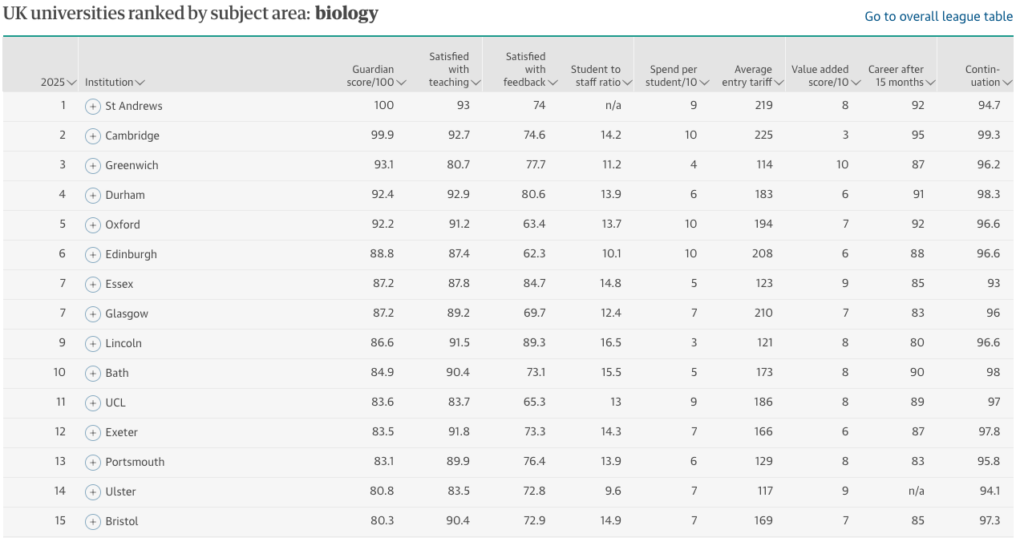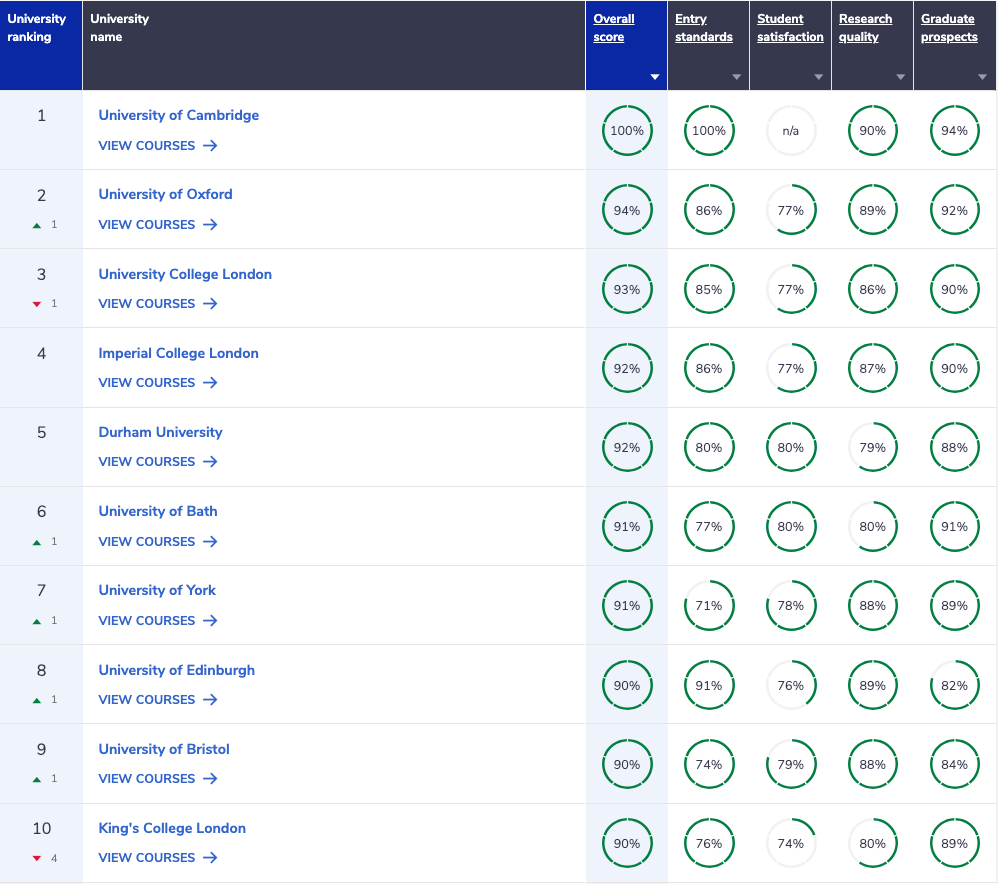As one of the three core sciences, Biology is a popular course to study in the UK. With over 90 universities to choose from, it can be tough to know where to apply to.
If you’re unsure of where to apply, there any many things you should research that will help you make your decision. One of the first steps to take is to look at university rankings to see which courses are considered the best in the UK.
In this guide, we’ll look at the two most widely used university ranking tables in the UK to see which Biology courses are considered the best. Let’s get started!
Who Makes The Biology University rankings?
It can be a bit confusing to have multiple tables exist when they are meant to provide objective rankings, but this isn’t really the case. The rankings are actually less objective than you may think, as they differ based on how each organisation interprets the data and assigns scores to universities. Although the data comes from similar sources, differences in how each organisation interprets and applies the information result in varying rankings.
Another thing to consider when looking at Biology rankings is what is actually classed as a Biology course. For example, the University of Cambridge features on both ranking tables despite only offering a broader Natural Sciences course, which allows students to specialise in Biological Sciences. Be wary of whether each course will actually provide what you’re looking for before making any decisions.
How reliable these tables are is also a topic to consider, but for now, let’s examine the full ranking tables for Biology and explore how each organisation presents their data.
Want to get your offer to study Biology at Oxford?
Hoping to study Biology at Oxford? You’ll need to write the perfect Personal Statement and interview like a pro to get your dream Oxford Biology offer.
Discover our Full-Blue Biology Programme for comprehensive admissions support by clicking the button below to enrol and triple your chances of success.
The Guardian Biology Rankings
To create their university rankings (including Biology), The Guardian uses the following metrics:
Guardian score/100 – rating of excellence based on a combination of the other factors.
Satisfied with the course – the rating of the overall quality of the course, given by final-year students in the latest National Students Survey (NSS) given as a percentage.
Satisfied with the teaching – the rating of the quality of teaching on the course given by final-year students in the latest NSS.
Satisfied with feedback – the rating of the feedback and assessment, given by final-year students in the latest NSS.
Student to staff ratio – number of students per member of teaching staff.
Spend-per student/10 – money spent on each student, excluding academic staff costs, given as a rating out of ten.
Average entry tariff – typical UCAS scores of young entrants to the department.
Value-added score/10 – this score compares students’ degree results with their entry qualifications, to show how effectively they are taught – given as a score out of ten.
Career after 15 months – percentage of graduates who find graduate-level jobs, or are in further study at professional or higher education level, within 15 months of graduation.
Continuation – percentage of first-year students continuing to second-year.
All of the data used is collected from various places, including the National Student Survey (NSS) for student satisfaction rates and the universities themselves, which provide details on admissions, spending, and more. Because the information comes from external sources, The Guardian’s rankings are free from any bias in terms of the data used.
The Guardian Biology University Rankings 2025
Here is the top 25 entries from The Guardian’s full league table for Biology degrees, including the results for 2025 and 2024 compared:
| Postition | University | Previous Position (2024) |
|---|---|---|
| 1 | University of St Andrews | 2nd (>1) |
| 2 | University of Cambridge | 3rd (>1) |
| 3 | University of Greenwich | 21st (>18) |
| 4 | Durham University | 4th (=) |
| 5 | University of Oxford | 5th (=) |
| 6 | University of Edinburgh | 9h (>1) |
| 7 (=) | University of Essex | 23rd (>16) |
| 7 (=) | University of Glasgow | 1st (<6) |
| 9 | University of Lincoln | 17th (>8) |
| 10 | University of Bath | 9th (<1) |
| 11 | University College London (UCL) | 8th (<3) |
| 12 | University of Exeter | 7th (<5) |
| 13 | University of Portsmouth | 18th (>5) |
| 14 | Ulster University | 28th (>14) |
| 15 | University of Bristol | 10th (<5) |
| 16 | Imperial College London | 10th (<6) |
| 17 | University of Liverpool | 12th (<5) |
| 18 | University of Dundee | 25th (>7) |
| 19 | University of Warwick | 13th (>6) |
| 20 | Aston University | 15th (<5) |
| 21 | Edge Hill University | 20th (<1) |
| 22 | Loughborough University | 14th (<8) |
| 23 | King’s College London | 19th (<4) |
| 24 | University of East Anglia (UEA) | 30th (>6) |
| 25 | Royal Veterinary College | 15th (<10) |
What can we see from this table? Let’s first look at the Top 10.
While there are various universities that typically perform well in ranking tables – such as Oxford, Cambridge and St Andrews – there are also a few outliers that aren’t as common to see this high. Universities like Greenwich, Essex and Lincoln are generally less well known and are normally seen around the middle of ranking tables. However, with strong scores in Value, Satisfaction and Continuation, they all place in the Top 10.
As well as this, we can see that some universities that typically do very well in ranking tables are in lower positions for Biology. This includes Imperial College London, UCL and Bristol, all missing out on the Top 10.
In terms of position changes compared to 2024, there were three universities that saw substantial boosts in their placements – Greenwich, Essex and Ulster. This indicates that these universities have all made major improvements in some way over the past year.
Within the Top 25, the Royal Veterinary College saw the biggest drop in its placement, falling from 15th to 25th. The University of Manchester, which was ranked 24th in 2024, fell 11 places to 35th this year. This shows how volatile these placements can be from year to year and why you should be wary when using them to decide your university options.
The Complete University Guide Biology Rankings
Next, we have The Complete University Guide. As mentioned earlier, this organisation collects data in a way that’s similar to The Guardian. But how do they make use of it? Below are the scoring metrics they use to compile their rankings:
Overall score – the total score calculated by The Complete University Guide’s independent and trusted methodology.
Entry standards – the average UCAS tariff of new students entering university.
Student satisfaction – a guide to how satisfied students are with the quality of teaching they receive.
Research quality – a measure of the quality of the research undertaken by the university.
Research intensity – a measure of the proportion of staff involved in high-quality research at the university.
Graduate prospects – outcomes – a guide to the success of graduates after leaving university.
Graduate prospects – on track – a measure of whether recent graduates agree that their current activity fits with their future plans.
Although the Complete University Guide groups its data into broader categories, the overall outcomes offer insights comparable to those in The Guardian’s rankings – though based on fewer metrics. Both rely on data from the NSS and universities themselves, but they differ in how they interpret and score that data. As a result, their rankings don’t always align.
Complete University Guide Biology University Ranking Table 2025
Now, let’s take a look at the top 25 entries of The Complete University Guide Biology ranking table, including the comparison to 2024’s rankings.
| Postition | University | Previous Position (2024) |
|---|---|---|
| 1 | University of Cambridge | 1st (=) |
| 2 | University of Oxford | 3rd (>1) |
| 3 | University College London (UCL) | 2nd (<1) |
| 4 | Imperial College London | 4th (=) |
| 5 | Durham University | 5th (=) |
| 6 | University of Bath | 7th (>1) |
| 7 | University of York | 8th (>1) |
| 8 | University of Edinburgh | 9h (>1) |
| 9 | University of Bristol | 10th (>1) |
| 10 | King’s College London | 6th (<4) |
| 11 | University of Glasgow | 12th (>1) |
| 12 | University of St Andrews | 11th (<1) |
| 13 | University of Warwick | 15th (>2) |
| 14 | University of Strathclyde | 13th (<1) |
| 15 | Lancaster University | 16th (>1) |
| 16 | University of Dundee | 17th (>1) |
| 17 | Queen’s University Belfast | 22nd (>5) |
| 18 | Loughborough University | 14th (<4) |
| 19 | University of Exeter | 21th (>2) |
| 20 | University of Manchester | 19th (<1) |
| 21 | Cardiff University | 18th (<3) |
| 22 | University of Birmingham | 20th (<2) |
| 23 | University of Leeds | 24th (>1) |
| 24 | University of Sheffield | 25th (>1) |
| 25 | University of Surrey | 23rd (<2) |
The Complete University Guide’s ranking table was much more stable compared to The Guardian’s and features far more universities at the top that you would expect to see. Among the Top 10, only one university is not a member of the Russell Group – the University of Bath. Russell Group universities generally perform very well in ranking tables, so this is not surprising to see.
Below this, even more Russell Group universities can be found, with very few entries that stray from the order of the overall university ranking tables. Within the list, only Strathclyde, Loughborough and Surrey could be considered uncommon picks, although these universities still perform fairly well in other subjects.
In terms of placement changes, the biggest difference came from Queen’s University Belfast, which rose five places to rank 17th. No universities in the Top 25 suffered a drop of more than 3 places, indicating that these placements have remained accurate since last year.
Access "The Big Book Of Oxbridge Applications" For FREE
Oxford offers a fantastic Physics degree, while Cambridge offers Physics within its Natural Science degree. Learn more about these two degrees in The Big Book Of Oxbridge Applications, which you can download for free here. Through over 350 pages, you’ll find:
- Over 40 admissions test practice questions
- 28 example Oxbridge Personal Statements
- Interviews with Oxbridge students and graduates
- Additional downloadable resources
Fill in your details below to claim your digital copy today!

The Best and Worst UK Universities For Biology
We’ve seen the top entries of each list, but what does the Top and Bottom 5 of each list look like? Bear in mind that these universities are only referred to as the “best” and “worst” in the context of the rankings and do not indicate that any of these are objectively bad.
Best Universities For Biology UK
Let’s start by examining the top five universities from each ranking. Comparing them will help highlight which institutions are consistently recognised as the leading choices for Biology in the UK.
Complete University Guide
- University of Cambridge
- University of Oxford
- University College London (UCL)
- Imperial College London
- Durham University
The Guardian
- University of St Andrews
- University of Cambridge
- University of Greenwich
- Durham University
- University of Oxford
The Top 5 entries for both tables are fairly standard when it comes to university rankings, although The Guardian does house a couple of surprises.
The Complete University Guide’s top 5 consists completely of Russell Group universities, with four out of five being G5 Universities as well (LSE – the fifth G5 uni – does not offer a Biology course). These are all very well-regarded universities, and Durham also typically performs well in university rankings.
The Guardian also gave high rankings to the Oxbridge universities, although Oxford received a lower rank than usual. However, Imperial and UCL are both ranked lower on the list (11th and 15th, respectively), instead being replaced by St Andrews and Greenwich.
The University of St Andrews is often placed in the Top 5 on Guardian rankings and is often considered the best university in Scotland, despite not being a member of the Russell Group. The bigger outlier is the University of Greenwich, which is rarely seen this high on any ranking table. The university scored well in “Value added” and “Continuation”, which may have boosted its score.
In comparison, Complete University Guide placed Greenwich at 59th and actually scored within the Bottom 5 of their 2025 Chemistry ranking table.

Worst Universities For Biology UK
Now, let’s take a look at the five lowest-ranked universities for Biology. Although these institutions appear at the bottom of the rankings, this doesn’t necessarily mean they provide poor-quality Biology degrees – they’ve simply scored lower in comparison to others.
Complete University Guide
- University of Worcester
- University of Cumbria
- Middlesex University
- University of Wolverhampton
- University of Staffordshire
The Guardian
- University of Cumbria
- Liverpool Hope University
- University of Roehampton
- Middlesex University
- University of Westminster
At the bottom of both lists are fairly unknown universities when compared to the iconic institutions featured at the top of the list. There are no surprising placements here either, so there’s not too much to analyse.
Between the two lists, two universities feature in both – Cumbria and Middlesex. Cumbria could be considered the lowest ranked overall, appearing at 93rd and 87th respectively (the Complete Uni Guide features 7 more universities on its list). However, it’s important to note that the university still received an overall score of 73% by Complete University Guide, while The Guardian recorded a student satisfaction rating of 94.2/100, the second highest on the table (Worcester scored 94.8!).
Between the other three entries on each list, the biggest variance was seen by Wolverhampton, which was placed at 68th by The Guardian. Overall, the results here aren’t too unexpected, but it; ‘s important to remember that these aren’t bad universities – just lower-ranked ones.
Which Ranking Table Should I Follow?
It’s best not to base your decisions solely on ranking tables, but what role can they play? Ideally, they should be used as a starting point in your research. While the rankings may vary, both tables generally do a solid job of identifying well-regarded universities, which can be helpful if reputation is a key factor for you. That said, it’s important to take other aspects into account too.
For example, if you’re focused on how well you might perform academically, it’s worth looking into the entry requirements and acceptance rates of each university to gauge where you’re most likely to gain admission.
If you’re hoping to apply to a top-ranking university like Oxford or Cambridge, you’ll face an even more rigorous application process, far higher entry requirements and lower acceptance rates (13.8% at Oxford and 16.6% at Cambridge). It’s important to make sure your current or predicted grades and general ability align with what these universities are looking for, so you can apply where you’re a strong candidate.
Statistics are just one part of the picture. University life goes beyond academics – most students spend at least three years living on or near campus full-time. That’s why it’s essential to consider whether you feel comfortable with the campus, facilities, and local environment before making your choice. Attending open days is a really good way of getting a feel for a university’s atmosphere and facilities, so be sure to visit the ones that interest you.
Lastly, it’s important not to overlook lower-ranked universities. While they may not match the prestige of top-tier institutions, many still provide a strong education and valuable opportunities, even if there are some trade-offs. If a lower-ranked university appeals to you, it’s definitely worth considering – these institutions often have less competitive entry, which could work in your favour. What matters most is that you’ve done your research and chosen based on the factors that are most important to you.
Conclusion
That wraps up our overview of Biology degree rankings in the UK. The main takeaway is that while these rankings can be useful, they only tell part of the story. For some, the data and scores may carry more weight, but it’s just as important to factor in your personal preferences when deciding which university is the right fit for you.
Most importantly, these rankings are neither definitive nor official. Given their variability, it’s up to you to determine which ones you trust and how much weight you give to rankings overall. Ultimately, if you choose a university that makes you happy, then the process you followed to reach that decision has been a success.
Are you worried about your Oxford chances? Don’t be – our Oxbridge offer success rate is 59%
Applying to Oxford Biology is immensely competitive, and it is crucial that you give yourself the best chance of success. We help you craft the perfect Personal Statement and teach you how to interview effectively, covering all areas of your Oxford Biology application.
Discover our Full-Blue Biology Programme now to learn how you can triple your chances of success.









